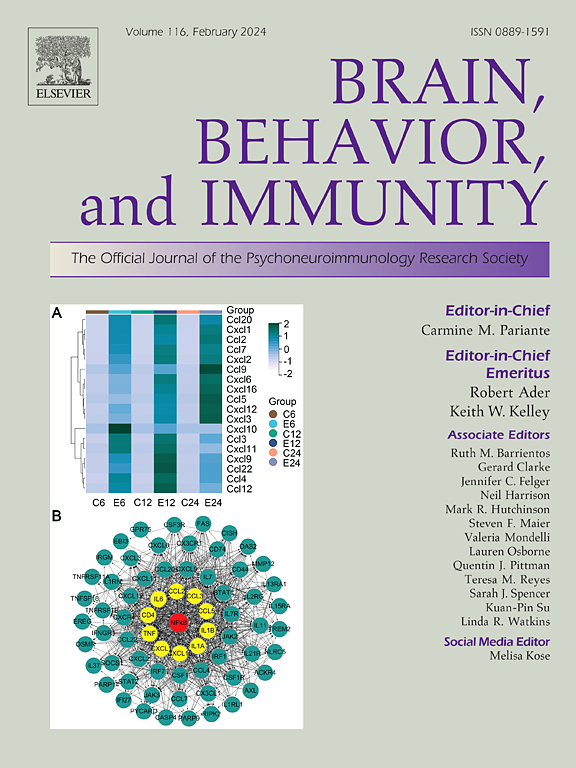Telomere-mitochondrial dynamics differ depending on childhood maltreatment history, catabolic postpartum state, and developmental period
IF 7.6
2区 医学
Q1 IMMUNOLOGY
引用次数: 0
Abstract
Telomere attrition, a hallmark of aging, is linked to high-energy demand states like early development and biological or psychological stress. Metabolic regulation of telomere length (TL) may occur in these states as part of an energetic trade-off, prioritizing immediate needs over long-term requirements such as telomere maintenance, though this has not been observed in healthy humans. We examined associations between TL and mitochondrial bioenergetics, density, and DNA markers in immune cells of women at 1-week (n = 175) and 1-year postpartum (n = 106), depending on their history of childhood maltreatment (CM), and in their newborns (n = 132). At 1-week postpartum, a catabolic state of high energy demand, women with lower mitochondrial energy production efficiency exhibited shorter TL. One year later, these dynamics appeared only in women with a history of CM. In newborns, TL was shorter when mitochondrial density-normalized routine and ATP production-related respiration was higher. Mitochondrial DNA copy number was associated with TL in both mothers and newborns, regardless of the energetic state. Our findings suggest that telomere-mitochondrial dynamics can adapt to the body’s energetic needs.
端粒-线粒体动力学取决于儿童虐待史、产后分解代谢状态和发育时期。
端粒磨损是衰老的标志,与早期发育、生物或心理压力等高能量需求状态有关。端粒长度(TL)的代谢调节可能在这些状态下作为能量权衡的一部分发生,优先考虑当前需求而不是端粒维护等长期需求,尽管尚未在健康人类中观察到这一点。我们研究了TL和线粒体生物能量学、密度以及产后1周(n = 175)和产后1年(n = 106)妇女免疫细胞DNA标记物之间的关系,这取决于她们的童年虐待史(CM),以及她们的新生儿(n = 132)。在产后1周,处于高能量需求的分解代谢状态,线粒体能量产生效率较低的女性表现出较短的TL。一年后,这些动态仅出现在有CM病史的女性中。在新生儿中,当线粒体密度标准化常规和ATP产生相关呼吸较高时,TL较短。在母亲和新生儿中,线粒体DNA拷贝数与TL相关,而与能量状态无关。我们的研究结果表明,端粒-线粒体动力学可以适应身体的能量需求。
本文章由计算机程序翻译,如有差异,请以英文原文为准。
求助全文
约1分钟内获得全文
求助全文
来源期刊
CiteScore
29.60
自引率
2.00%
发文量
290
审稿时长
28 days
期刊介绍:
Established in 1987, Brain, Behavior, and Immunity proudly serves as the official journal of the Psychoneuroimmunology Research Society (PNIRS). This pioneering journal is dedicated to publishing peer-reviewed basic, experimental, and clinical studies that explore the intricate interactions among behavioral, neural, endocrine, and immune systems in both humans and animals.
As an international and interdisciplinary platform, Brain, Behavior, and Immunity focuses on original research spanning neuroscience, immunology, integrative physiology, behavioral biology, psychiatry, psychology, and clinical medicine. The journal is inclusive of research conducted at various levels, including molecular, cellular, social, and whole organism perspectives. With a commitment to efficiency, the journal facilitates online submission and review, ensuring timely publication of experimental results. Manuscripts typically undergo peer review and are returned to authors within 30 days of submission. It's worth noting that Brain, Behavior, and Immunity, published eight times a year, does not impose submission fees or page charges, fostering an open and accessible platform for scientific discourse.

 求助内容:
求助内容: 应助结果提醒方式:
应助结果提醒方式:


